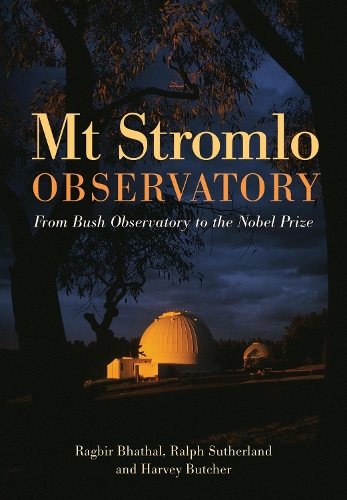
Mt Stromlo Observatory: From Bush Observatory to the Nobel Prize
(Hardback)
Publishing Details
Mt Stromlo Observatory: From Bush Observatory to the Nobel Prize
By (Author) Ragbir Bhathal
By (author) Ralph Sutherland
By (author) Harvey Butcher
CSIRO Publishing
CSIRO Publishing
2nd December 2013
Australia
Classifications
Professional and Scholarly
Non Fiction
520
Physical Properties
Hardback
314
Width 170mm, Height 245mm
Description
This book tells the story of the Mt Stromlo Observatory in Canberra which began life as a government department, later becoming an optical munitions factory producing gun sights and telescopes during the Second World War, before changing its focus to astrophysics the new astronomy.In the ensuing years programs were introduced to push the Observatory in new directions at the international frontiers of astronomy. The astronomers built new, better and larger telescopes to unravel the secrets of the universe. There were controversies, exciting new discoveries and new explanations of phenomena that had been discovered.
Author Bio
Ragbir Bhathal is an award winning author and astrophysicist in the School of Computing, Mathematics and Engineering at the University of Western Sydney, Australia. He has published eight books on astronomy and several papers in international refereed journals. He was the Foundation Director of the Singapore Science Centre, a UNESCO Consultant on science policy and science centres, and an Adviser to the Federal Minister for Science. He was awarded the prestigious Nancy Keesing Fellowship, the C J Dennis Award for excellence in natural history writing and the 1988 Royal Society of NSW medal for services to science and research. He is the Director of the Australian Optical SETI Project and a Visiting Fellow at the Research School of Astronomy and Astrophysics at the Australian National University.
Ralph Sutherland is a Research Fellow at the Research School of Astronomy and Astrophysics at the Australian National University. He has published widely in international refereed journals, and has a textbook on the astrophysics of the interstellar medium.
Harvey Butcher is well known for the discovery of the Butcher-Oemler effect and the design and implementation of advanced astronomical instrumentation including LOFAR (Low Frequency Array for Radio Astronomy), one of the largest radio telescopes in the world. Before taking up the position of Director of the Research School for Astronomy and Astrophysics at the Australian National University, he was the Director of the Netherlands Foundation for Research in Astronomy (ASTRON). He was awarded the knighthood of the Order of the Netherlands Lion in 2005 for contributions to multidisciplinary science innovation and public outreach.
